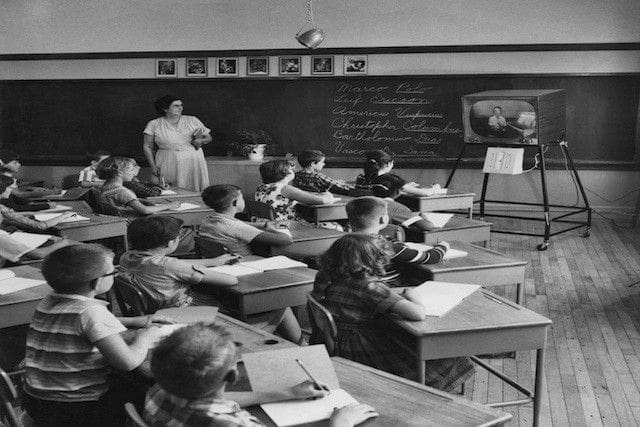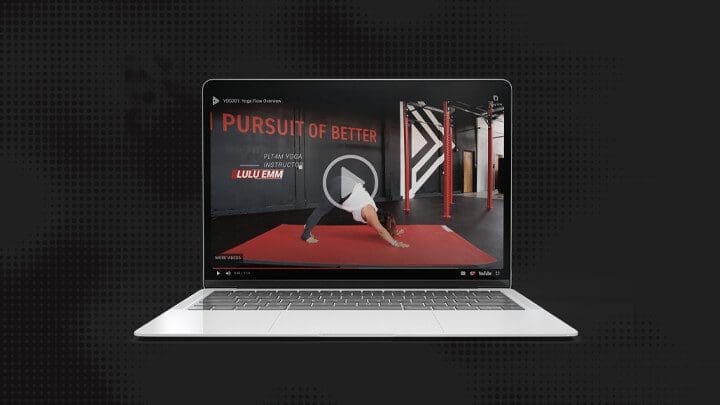Online videos have become one of the most popular learning materials used in schools. From shorter videos to full video lessons, teachers utilize video learning all throughout the school day. So how do videos help students learn in PE? This article will explore how using videos in PE can improve student engagement and facilitate deeper learning.
The History of Using Video In Education
The use of videos to enhance the learning process for students is not new. As early as the 1940s, schools were wheeling in TVs on carts to bring video content into the classroom.
In as early as 1968, studies showed that people generally remembered:
10% of what they read
20 % of what they hear
30% of what they see
50% of what they see and hear

In 2004, the Corporation for Public Broadcasting released a report citing educational television:
Reinforces reading and lecture material
Aids in the development of a common base of knowledge among students
Enhances student comprehension and discussion
Provides greater accommodation of diverse learning styles
Increases student motivation and enthusiasm
Promotes teacher effectiveness
For years now, teachers have embraced videos to enhance student learning. In the last few years, though, digital videos and online videos have become widely available. Now, educational videos have the potential to take student learning to a whole new level as a go-to teaching tool.
The Challenge of Using Video In Education
Using video in education goes far past blended learning and flipped classroom buzzwords. The use of videos in education can range from tapping into shorter videos to full-blown video lessons.’
When deciding what video content makes the most sense for your students, it is important to consider the learning goal.
For example, educational videos can introduce new information to students for the first time. Beyond new information, digital videos can be used throughout class time to guide students through activities and help to deepen their understanding of key concepts.
But pairing the right videos with your learning goals doesn’t come without challenges. Not all videos are created equal. There are millions of online videos to choose from, and many of them do not constitute effective educational videos.
In physical education, teachers often search youtube for video lessons only to find videos that are a far cry from quality educational materials.
Instead, most fitness and health-related videos are not aligned with the standards and goals of the class. On top of that, many of the videos are not appropriate for classroom use because of the instructor’s clothing or lack thereof.
Benefits of Integrating
Technology in Physical Education
Learn how physical education departments are benefiting from embracing technology in their classrooms
How Do Videos Help Students Learn In PE?
In physical education, online videos can be utilized to improve the learning experience in various ways. In this next section, we will look at some of the different types of educational videos that physical education teachers use across the country with PLT4M.
PE teachers utilize PLT4M to incorporate technology in PE and draw from the library of over 2,000 educational videos. All of the video content available through PLT4M is explicitly made for middle and high school students so that teachers can trust the quality of instruction in every single video.
4 Different Examples of Using Videos In PE
So how do videos help students learn in PE? In the following few examples, we will break down what type of video it is and talk about how it is most commonly used in schools to help students learn.
Instructional Video - Demo
In this video, students are introduced to the air squat. This video has two intentional components to help assist in student learning.
Part 1: Movement Demonstration: Students can visually see a few good repetitions of the air squat.
Part 2: Coaching Instruction and Breakdown: Students can listen and watch our instructor breakdown both with visual and auditory cues the different pieces of the air squat.
Although this is considered one of PLT4M’s shorter videos, it has a lot of value packed into one minute. If air squat is assigned within a workout or lesson for a class, different students can go at their own pace but access this fundamental movement when they are ready. Some might need a quick refresher and only watch the demonstration piece. Other students might watch and possibly rewatch the whole video within the same class to go a little deeper if necessary.
Follow Along Video Lessons
Within PLT4M’s library, there are endless hours of on-demand follow-along video lessons. These lessons range in topics like pilates, dance, yoga, mobility, and more. These videos take students through a guided lesson and coach them as if they were in a studio or class at a local gym.
These videos help students learn about many different fitness options that otherwise wouldn’t be available at their school. Often, PE teachers not comfortable teaching a full yoga, pilates, or dance class will bring in an outside guest but then are left to search for on-demand lessons elsewhere.
Better yet, now teachers can walk about the classroom and provide more hands-on instruction rather than having to lead the entire class at the front. Follow along with full video lessons can go a long way!
Video Lectures
Not every aspect of physical education is activity-based. But that doesn’t mean PE cannot benefit from high-quality video instruction in the classroom setting. In this example, PLT4M’s nutrition expert Rebecca Toutant discusses carbohydrates. This video is paired with a written lesson to create a complete comprehensive multimedia learning experience.
Teachers will often open up the class for a group discussion from this lesson. Students can learn and explore nutrition and many other cognitive topics through video lectures by incorporating video.
Tip Videos
While many videos often show students how to do things the RIGHT way, what happens when students do things the wrong way? Tip videos like these help to highlight a common fault seen in students and give tips and strategies to help fix it. These videos can be incredibly powerful for students because it allows them to safely explore problems and then improve them.
How Do Videos Help Students Learn? Final Thoughts
There is a lot to learn from videos in physical education. One important thing to remember is that using videos in class does not replace a teacher but instead supports them with additional resources.
Many teachers will still teach the fundamental concepts of movement and form and supplement students with instructional videos along the way.
One of the biggest advantages teachers have found using videos in PE is that they go from feeling like they are the only teacher in the room to having a network of support around them. Molly Collins, a PE teacher in Michigan describes the power of video,
“With the instructional videos, I can get to so many more students. So many of the little questions get answered by video, which gives me added time and freedom to go be hands-on with students who need extra help.”
Not only does it make being a PE teacher more manageable, but it also has a direct impact on student engagement. As we live in a digital age, more and more students are drawn to information that is packaged through video. Student engagement with videos is at an all-time high! Take advantage of it in your PE class.
FAQ
What technology do you need for the use of videos in teaching and learning?
Almost any type of technology in physical education will allow you to use videos in teaching and learning.
Some schools allow students to use their phones. Other schools have students on one-to-one devices like tablets or Chromebooks. In many schools, a projector or TV monitor is used for a lot of the follow-along style content featured in this article.
Does PLT4M only have videos?
No, PLT4M also has technology to deliver the videos via a web and mobile app. You can also track and monitor student progress and activity with the app. Consider PLT4M a comprehensive tool for PE.






